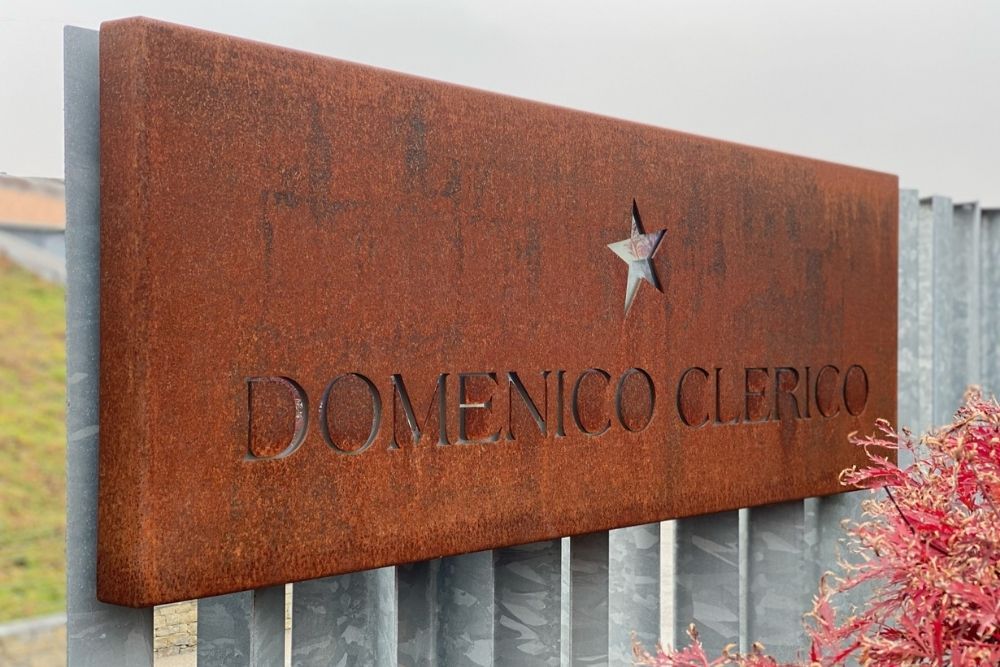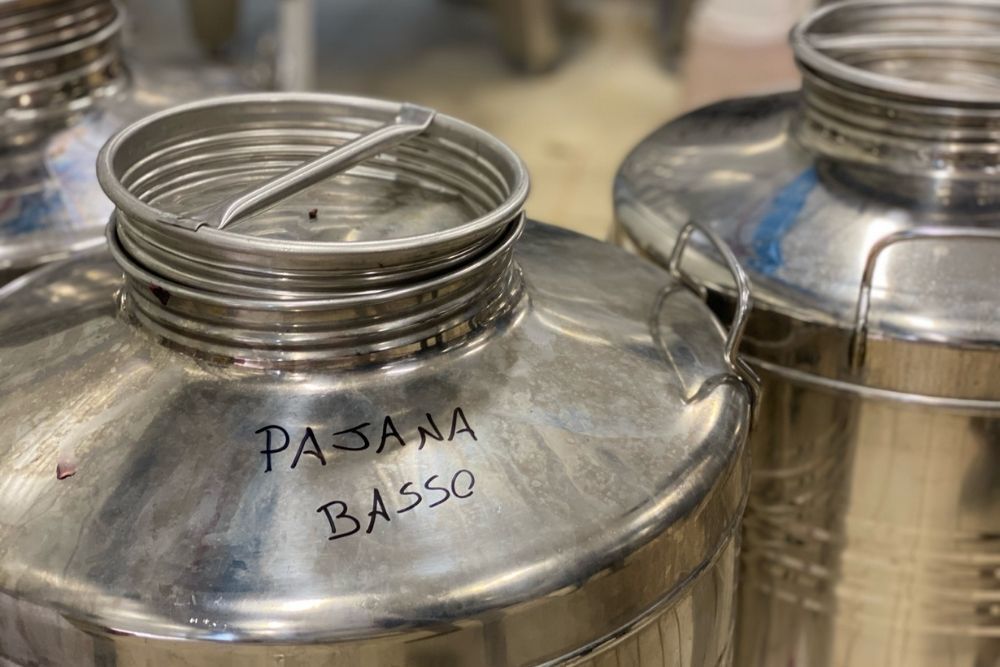“Everyone loves a Ferrari, but Fiat runs the country,” writes Turner.
As strange as it sounds, my wine travels in Piemonte rarely take me to the communes of Barolo. Having visited the region at least once a year since the turn of the century, we’ve been lucky to make some great friends amongst winemakers. They just so happen to be in other parts of Piemonte and often have their own success stories to celebrate like Gianni Doglia.
My minimal exposure to these famed rolling hills south of Alba is something that I’ve been keen to rectify, so when I had the chance to get away for a week in October, an invitation to meet a lockdown-wine-friend at the renowned Domenico Clerico in Monforte D’Alba, it was too good an opportunity to miss. Armed with my notebook, and a determination to scratch more off the surface of this much lauded region, I jumped in the rented Cinquecento and headed out on the road…
Domenico Clerico: one of the visionaries of Monforte D’Alba

Domenico Clerico founded his eponymous winery in 1979, only a few years after taking over his father’s modest vineyard holding. Along with other Barolo luminaries such as Elio Grasso and Aldo Conterno, Domenico Clerico was part of the boom years for both the previously underrated commune of Monforte D’Alba, and the often unfashionable (believe it or not) wines of Barolo. The 1980s and 1990s saw a modernisation in style and technique, led by producers such as Domenico. They produced more consumer friendly, easily approachable expressions of Barolo, but never compromising on luxury with a clear aim to make Barolo great.
Domenico Clerico was also greatly enthused by the move to highlight single vineyard expressions of Barolo, but always with an eye on consumer perception. In 2010, the Consorzio announced 170 MGAs across, and in addition to, the 11 communes of Barolo. These are the Barolo cru vineyard sites, drawn up in collaboration with both technical reports and no small amount of producer input. Whilst other communes of Barolo came up with 30 or 40 each, the producers of Monforte D’Alba controversially argued for just 11.
Barolo traditionalists argued that these large crus, including Bussia and Ginestra where Domenico had plantings, almost missed the point of single vineyard expressions due to their size. The producers of Monforte retorted that the consumers had already come to recognise the terms “Ginestra” and “Bussia” on the labels, so why waste that brand recognition? Rightly or wrongly, buying wines in Monforte continues to be more skewed towards finding producers you know and trust.
It was a sad loss to lovers of Italian wines when, in July 2017, Domenico finally succumbed to a long illness. But the winery moves on under the guidance of Domenico’s wife, Giuliana, and general manger Oscar Arrivabene, our fabulous host for the day in October. Honouring the legacy of what Domenico achieved is clearly a driving motivation for all. The team still see their founder as a star in the in the sky looking over them, so much so that they named an asteroid after him!
A modern winery for modern Barolo

When you arrive at the gates of Domeinco Clerico, the building itself reflects the nature of the wines. Its concrete and steel construction is modern and powerful, yet its curved design was intended to subtly blend in with the surrounding hillsides. It works, so much so that I missed it completely and ended up in a farmhouse 200 metres down the road. I blamed the sat nav of course!
The winery is fast evolving. I’d felt guilty that we’d arrived a week before harvest was set to end, but Oscar relished the opportunity to showcase the winemaking team’s latest projects as the grapes began to macerate and ferment. The vines are planted from 220m to 420m across their holdings, a large range in this region leading to very different grape profiles arriving at harvest. Even within their single cru wines, the grapes from different parts of the vineyard are reacting in different ways. Parcels from across Ginestra cru, destined for their Pajana label, were split – some fermenting in barrels, some stainless steel,; some whole bunch, others not.
The new vat room is filling up quickly, with many smaller vessels replacing the previously large tanks. They now commonly use 10-15hl vinification tanks, rather than 40hl which were used in the past, although some 100 litre microvinifications were in full swing on our visit. A combination of experience and mathematical modelling techniques allow them to, as best possible, predict harvest and vintage conditions. The parcels are then kept separate, not only for blending and experimenting, but also to track how the sites are evolving over the years. As Oscar put it “each site’s imperfections are perfect in their own way and we want our single vineyard wines to express that. If you have a Bussia, it should taste like a Bussia, otherwise why pay the €2m per hectare for the vineyards?”
The Tre Bicchieri award from Gambero Rosso for the 2017 Ciabot Mentin from Ginestra clearly meant a great deal for their confidence in the path they’re taking. This was especially meaningful as it was the first vintage after the passing of Domenico.
An identity beyond Nebbiolo

Domenico Clerico currently produces around 120,000 bottles a year, with over half the production destined for exports. Of the nine labels that Domenico Clerico makes, seven of them are Nebbiolo or Nebbiolo-based blends (you’d expect nothing less in this region) but it’s not as simple as all that. “We’re very proud of our plantings” states Oscar, “most vines are now over 30 years old and we have an interesting masale selection of clones. By vinifying separate plots we can control the output, but the variety gives us insurance for future issues, especially with the climate.”
Domencio Clerico now has vines in four of the crus of Monforte D’Alba. The majority are in Ginestra, with some also in the neighbouring cru of Mosconi, and small parcels in Bricco San Pietro and Bussia. About 15 years ago these were joined with vineyards in the neighbouring commune of Serralunga D’Alba, from which their iconic Aeroplanservaj label was born.

So what about the other two labels? Another legacy of Domenico is the winery’s insistence on making both varietal Barbera and Dolcetto. The discussion about Dolcetto is probably the moment I think Oscar and I clicked. We’re both big fans, a fact we found out as he pointed out the vineyards to me from the balcony of the winery. Oscar noted that, although frosts are an increasingly regular occurrence, every year they’re on the same slopes. If they plant Dolcetto, they get great wines in areas the Nebbiolo wouldn’t survive, especially as Nebbiolo famously doesn’t really do post-frost secondary bunches.
In producing Barbera and Dolcetto, it’s also a nod to the cultural legacy of this region. I didn’t realise how undervalued Barolo was as recently as the 1980s. In 1983 they released their first vintage (1981) of Langhe Rosso (more on that later) as a blend of Barbra, Dolcetto, and Nebbiolo. “We used it as a Trojan Horse,” jokes Oscar, “to get rid of our Nebbiolo.” Barbera and Dolcetto have remained a winery favourite ever since and reflects the link to the community around the winery. Oscar’s point that “everyone loves a Ferrari, but Fiat runs the country” was beautifully put.
Wine and culture

By all accounts, Domenico was a man of many passions which was instilled throughout the winery. This is why the Arte Project launched from the start of 2020, clearly means so much to the current team. It’s a competition launched with the Albertina Academy of Fine Arts in Torino to support and promote young talent. Each year the two winners will have their artwork used on limited edition bottle labels and be commissioned to produce a larger piece for display in the barrel room at the winery.
This year’s winners were Eleonora Ballario and Francisca Jitaru, whose five label designs each can adorn any of the 300 limited edition double magnums of the Arte Langhe Rosso DOC. A configurator on the website allows you to reserve your magnum, pick your favourite label, and your own choice of colour of wax, and have your name and a personal message embossed on the label too.
Oscar enthuses that it’s about personalising the wines for an extra dimension of the story when your friends are over for dinner. The culture of this wine is more than just the vineyards. “Arte is a wine which has its own signature style, different in each vintage and not replicable, just as the work of the artists is not replicable. A wine that well represents Domenico Clerico, an eclectic man, innovator and visionary, in the vineyard, in the cellar and above all in life”.
The wine itself is a modern take on Domenico’s 1983 Langhe Rosso, this time with 60% Nebbiolo and 40% Barbera, but with only 30% new oak to allow the expressive notes of cherries, plums, strawberries, herbs, and rose petal to come to the fore. A classic and very luxuriously-produced Langhe Rosso.
Future trips to Barolo

My conversations with Oscar, of course, included much more talk about the particulars of the terroir of Monforte D’Alba. I fear they are either too basic or too geeky to include in this report. But, as well as adding to my knowledge base on the communes and crus of Barolo, it also changed the way I think about my future visits to Barolo. Stupid though it may sound, I’m still nervous about visiting ‘luxury’ wine regions without prior invitation and a Wine Press badge on my jacket. This trip will make me stop worrying as much. Modern Barolo, it seems, also appreciates a visit from wine enthusiasts as much as the lesser-known regions of Piemonte where I so enjoy spending time.
Oscar and his team were warm and hospitable (thanks Giorgia!) and thoroughly enjoyable to spend an afternoon with, that joyously went on much longer than any of us anticipated. And I also came away genuinely regretting that I never had the opportunity to meet Domenico himself. For those of you that were lucky enough to do so, I hope he was everything I imagine him to be, and hope that the current team at Domenico Clerico continue to uphold his undoubted legacy.
Domenico Clerico wines are available in the UK. For more information, please contact Giorgia Zucco at Domencio Clerico or Michele Marmino at Zed Comm PR.
Mike Turner works as a wine writer, educator, presenter, and judge through his company Please Bring Me My Wine. He also runs wine events and e-commerce business, Feel Good Grapes from his base in the East Midlands.
































